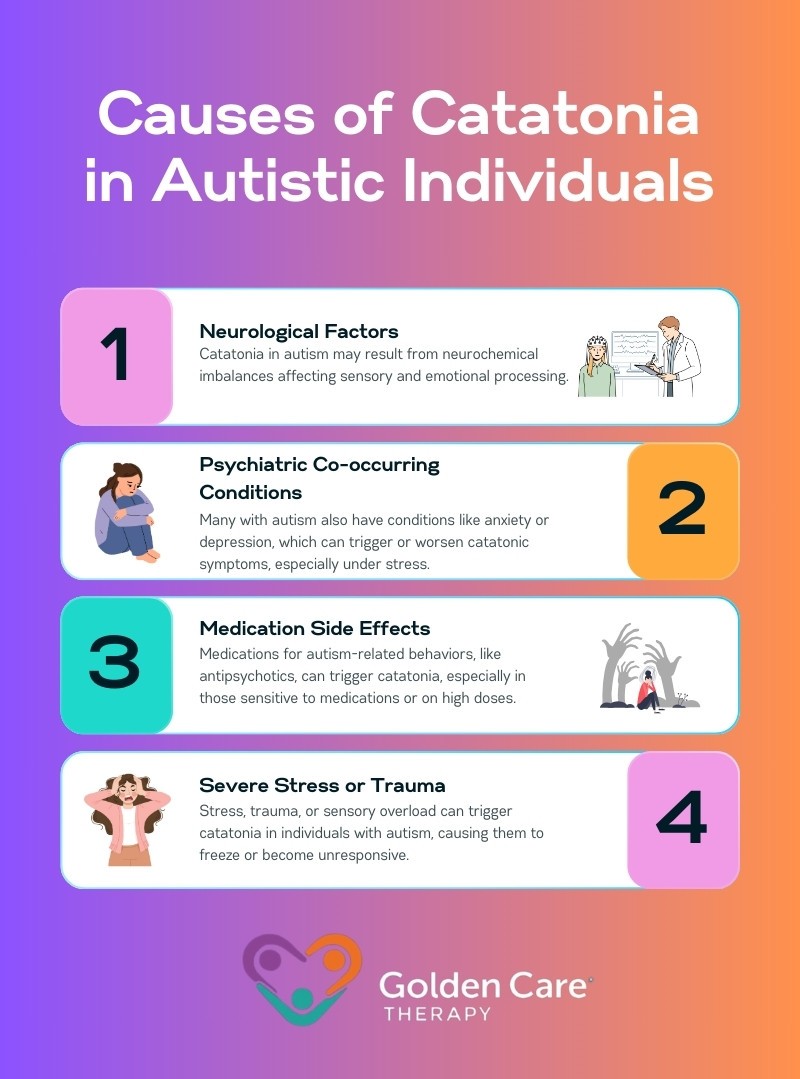Catatonia is a complex neurological condition that can present itself in individuals with autism, including those diagnosed with fragile X syndrome. It is marked by a range of physical and behavioral symptoms, which can be alarming and challenging to understand.
While catatonia is more commonly associated with other mental health conditions, it has been increasingly recognized as a co-occurring disorder in individuals with autism. That said, let’s look at what catatonia is and its key symptoms you should watch out for.
What is Catatonia?
Catatonia refers to a state of psychomotor dysfunction that can involve a variety of symptoms, such as immobility, rigidity, and excessive motor activity. It is often misunderstood as simply a lack of movement or response, but it is much more complicated.
Catatonia can be triggered by a range of psychiatric or medical conditions and can occur with both mental and physical manifestations.
In the context of autism, catatonia is not always well-recognized, but it may be more prevalent than once thought. Individuals with autism may show signs of catatonia during periods of heightened stress or anxiety, leading to confusion and difficulty in interpreting their behavior.
It is important to distinguish catatonia from other behavioral challenges common in autism, as it requires different treatment approaches.
Catatonia in autism presents itself in a range of behaviors that can often mimic other conditions or be attributed to autism itself. However, specific symptoms are commonly observed in individuals with both autism and catatonia.
These symptoms are as follows:

Immobility or Waxy Flexibility
A hallmark of catatonia is a person’s inability or unwillingness to move, even if the person is physically capable. In autism, this can be mistaken for a shutdown or a response to overwhelming stimuli.
In more severe cases, individuals may demonstrate “waxy flexibility,” a condition in which their limbs remain in a fixed position after being moved by another person.
Mutism or Limited Speech
While individuals with autism may have varying degrees of communication abilities, catatonia can lead to periods of mutism, where the person is unable or unwilling to speak. This can result in confusion and misinterpretation of the individual’s condition as a communication disorder rather than a response to underlying catatonia.
Posturing and Odd Movements
Catatonia may cause strange postures or repetitive movements. In autism, these behaviors could be mistakenly thought of as part of stereotypical behaviors, but when paired with other symptoms of catatonia, they may indicate a different issue. These movements can include sudden, jerky motions or maintaining a rigid posture for long periods.
Agitation and Hyperactivity
Some individuals with autism who experience catatonia might display the opposite of immobility, becoming hyperactive or agitated. They may exhibit restlessness, pacing, or extreme emotional reactions to minor stimuli.
This can complicate the diagnosis because agitation in autism is often attributed to anxiety or sensory overload.
Repetitive Behaviors
Repetitive behaviors such as hand-flapping, rocking, or repeating phrases may also coincide with catatonia. When these actions are performed in conjunction with other symptoms, it becomes crucial to assess if they are signs of catatonia or if they are simply part of the person’s routine autism behaviors.
Causes of Catatonia in Autism
Catatonia’s exact cause isn’t fully understood, but several factors can contribute to its development. Some notable examples include:

How to Diagnose Catatonia in Autism
Diagnosing catatonia in individuals with autism can be particularly challenging due to overlapping symptoms with other autism-related behaviors. Often, behaviors such as immobility or repetitive movements are mistaken for signs of autism itself, making it harder to identify catatonia.
Clinicians often rely on careful observation and a thorough medical history to identify catatonia in individuals with autism. They may look for patterns of immobility, mutism, posturing, or other unusual behaviors that do not fit within typical autism traits. Observations during periods of heightened stress or anxiety are especially helpful in making the distinction.
To assist in diagnosing catatonia, clinicians may use standardized rating scales such as the Bush-Francis Catatonia Rating Scale. This scale evaluates the severity and frequency of symptoms like immobility, mutism, and posturing, helping clinicians assess whether catatonia is present.
It is also crucial to rule out other medical or psychiatric conditions that may mimic catatonia. For example, seizures, severe depression, and certain neurological disorders can present with similar symptoms, making it important to conduct a comprehensive evaluation.
4 Treatment Options for Catatonia in Autism
Treating catatonia in autism requires a multifaceted approach, as both the catatonia and the underlying autism must be addressed. Here are some of the most common treatment options:
Medication
Benzodiazepines, particularly lorazepam, are effective in alleviating symptoms of catatonia in some cases. Antipsychotics and mood stabilizers are also used cautiously, as they may either help or worsen symptoms depending on the individual. Medications must be prescribed and monitored carefully to avoid adverse effects.
Psychotherapy
Psychotherapy, particularly cognitive-behavioral therapy (CBT), may help individuals with autism manage stress and anxiety, which are often triggers for catatonia. Though more challenging in non-verbal individuals, adapted forms of therapy can still provide support by focusing on sensory regulation and behavioral interventions.
Sensory Integration Therapy
Sensory integration therapy, which is commonly used in autism treatment, may also be helpful for individuals with catatonia. This therapy aims to help individuals process and respond to sensory input more effectively, which can reduce the likelihood of stress-induced catatonia episodes.

Physical Therapy and Occupational Therapy
For individuals with severe catatonia symptoms, physical and occupational therapy can help restore motor function and reduce the physical limitations caused by immobility or rigidity. These therapies also assist in improving overall quality of life by addressing the functional impairments caused by catatonia.
The Bottom Line
Understanding and managing catatonia symptoms in autism requires patience, careful observation, and the involvement of a comprehensive treatment team. Early recognition of symptoms, proper diagnosis, and an individualized treatment plan can help mitigate the impact of catatonia on individuals with autism.
Through a combination of medical, behavioral, and therapeutic interventions, many individuals with autism who experience catatonia can improve their functioning and quality of life.
Caregivers, clinicians, and families should work together to ensure that all factors contributing to the person’s health are addressed, including the underlying autism, psychiatric co-occurring conditions, and the specific manifestations of catatonia. At Golden Care Therapy, we provide high-quality ABA therapy in Florida, New Jersey, Indiana, New York, and Georgia, offering personalized treatment plans designed to support each individual’s unique needs.
Our dedicated team is committed to helping individuals thrive through compassionate, evidence-based care. Contact us today to learn how we can support your loved one’s journey.
Sources:



